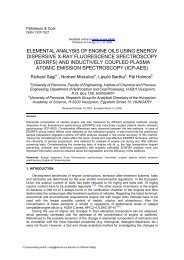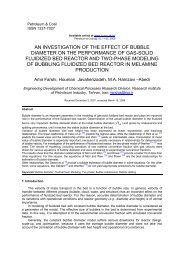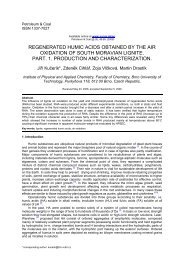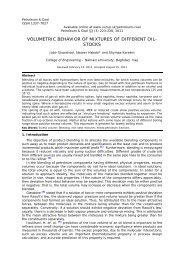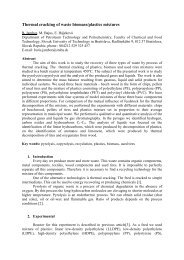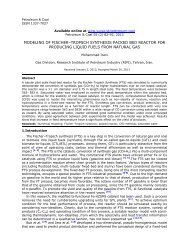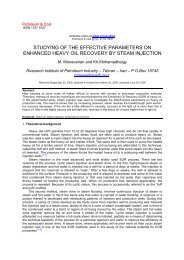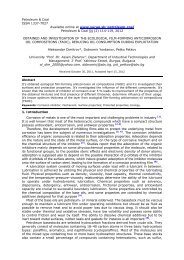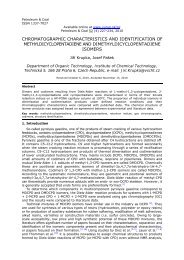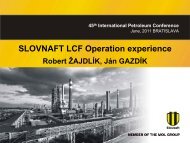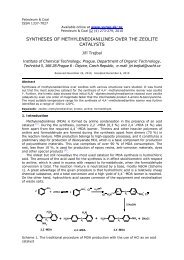ZERO CARBON POWER GENERATION: IGCC AS THE PREMIUM ...
ZERO CARBON POWER GENERATION: IGCC AS THE PREMIUM ...
ZERO CARBON POWER GENERATION: IGCC AS THE PREMIUM ...
Create successful ePaper yourself
Turn your PDF publications into a flip-book with our unique Google optimized e-Paper software.
Pre-combustion decarbonization is exclusivelybased on the <strong>IGCC</strong> technology. In the firststep, fossil fuel is transformed to synthesis gas(syngas), basically mixture of carbon monoxide(CO + H 2 ). Syngas is then purified by one of thestandard manners used with <strong>IGCC</strong>. In the nextstep CO is converted to H 2 + CO 2 via water-gasshift(WGS) reaction. CO 2 is then separated byconventional methods. Its separation, however,consumes much less energy, because it takesplace in a smaller reaction volume with lowervolumetric flow rates, elevated pressure andhigher component concentration. Higherconcentrations make the capture process lessenergy intensive. Penalty in the loss of energygeneration is typically 10-16% - half the one in apost-combustion decarbonization process. Thistechnology is therefore definitely more effectivethan the postcombustion and slightly moreeffective than oxy-fuel decarbonization.Novel concepts are based on techniques whichare yet in the pilot-scale or even laboratory stageof development. Membrane processes of CO 2separation or chemical looping are examples ofthese longer-term outlook technologies.Carbon sequestration. General consent hasbeen accepted that the current trend of CO 2emissions is not acceptable. It should bereduced by several methods out of which carbonsequestration is generally supposed to play itsimportant role in the future. By means of thistechnique CO 2 will be kept apart of theatmosphere by injecting it under surface. Itsretention under the surface must be long enough(in order of centuries or one millennium) until theglobal atmospheric CO 2 equilibrium is reestablished.This can be accomplished by eitherof the following methods.Carbon sequestration in geologic formations.This route has the following options.• Storage in deep coal beds• Storage in depleted oil and gas fields• Storage in deep saline formationsCarbon sequestration in deep sea can berealized in various depths from 600m down to3000 m and more.Environmental benefits of the carbon captureand sequestrationAnthropogenic carbon emissions in theatmosphere are generally believed to beincrementally causing an imbalance in the globalcarbon cycle. Since the mid 19th century theyhave steadily grown by 2% annually up to theamount of 24 Gt/a CO 2 as of 2001. This isadequate to 6.5 Gt/a in carbon equivalent. Morethan half of this amount, 3.5 Gt/a, retains in theatmosphere while the balance is absorbed bythe ocean and terrestrial biosphere. Cumulativeamount of 260 Gt of carbon has been releasedfrom the burning of fossil fuels during theindustrial period of the last 150 years.Global climate change. The contribution ofhuman-made CO 2 flux caused that the CO 2concentration in the air has increased from 280ppmv in 1850 to the current value of 360 ppmv.At the same time the global averagetemperature at the surface of the earth hasincreased by 0.8 °C.Before this change occurred the temperatureand CO 2 concentration profiles were swingingwith almost regular amplitudes within the rangeof coordinates and respectively. Such course lastedthroughout the history of the previous 420,000years. Correlation between the temperature andcarbon concentrations is evident.Stabilizing GHG concentrations is by far morestringent target than stabilizing emissions. It mayrequire that anthropogenic emissions mustapproach zero level unless legacy issues forfuture generations are left behind ourgeneration.Routes how to achieve such requirement areversatile. Their outline can have a followingstructure.• Improved efficiencyo Improved efficiency on thesupply sideo Improved efficiency on thedemand side• Fuel switchingo Fuel switching towards higherH/C ratio (coaloil, coalgas,oilgas)o Nuclear power
The formula of technological sequenceSyngas generation block Water gas shift reactor CO 2 capture GTCCis typical, yet not inevitable. Modifications to this standard may occur in the sequence of refinery steps.A similar flow diagram of an <strong>IGCC</strong> system integrated with carbon capture based on natural gas feedstockis shown in Figure 4.Natural gasSteamOxygenOxygen + steamCO 2Syngas generation blockAlternatives:Shift converterSteam methane reforming (SMR)CO + H 2 O CO 2 + H 2CH 4 + H 2 O = CO + 3H 2 (1)Partial oxidation (POX)CH 4 + 0.5 O 2 = CO + 2H 2 (2)Autothermal reforming (ATR)Combination of reactions (1) & (2)CO2 reformingCH 4 + CO 2 = 2CO + 2H 2 (3)SyngasGTCC BlockG STHRSGO 2 , N 2 , H 2 OFlue gasFigure 4: Simplified flow diagram of <strong>IGCC</strong> system based onequipped with pre-combustion capture of CO 2CO 2captureHFlueGas turbinenatural gasCO 2 to sequestration2 richgasAirGaThe difference between both schemes is in theutility sense of the <strong>IGCC</strong> concept itself. In thecase of heavy fuel feedstock application of the<strong>IGCC</strong> concept is inevitable whether thesequestration stage follows after it or not. This isbecause heavy fuel cannot be burned in a gasturbine. On the other hand, <strong>IGCC</strong> concept in thecase of natural gas feedstock would not bejustified without the existence of a downstreamsequestration stage. Conventional GTCC (GasTurbine Combined Cycle) would be preferableinstead.The fact that in both cases the gas turbine isfired with hydrogen rich fuel deserves attention.Commercial gas turbines are normally designedfor natural gas or oil operation. Theircompatibility to hydrogen operation needscertain redesign, though not substantial.When using natural gas as feedstock, syngas isproduced by either of technologies outlined inFigure 4. The CO is reacted with steam in acatalytic process of the WGS reaction toproduce CO 2 and highest possible amount of H 2 .After the CO-conversion and removal ofcondensate, the gas mainly consists of H 2 withCO 2 . The CO 2 can then be separated bychemical or physical absorption for disposal oruse. The H 2 can be used as a chemicalfeedstock, or as fuel in a GTCC plant oreventually a fuel cell. Chemical or physical gasabsorption equipped with a strippingregeneration stage, generally called as the ColdGas Cleanup – CGU has been used almost7
exclusively for the syngas desulphurization in allof the <strong>IGCC</strong> projects realized (except for PinonPine Sierra Pacific) up to date. What was goodfor desulphurization will be good for decarbonisationas well, even though with appropriatemodifications. At least such are conclusions ofmajority of research & development studies onthis subject.Elevated pressure and relatively highconcentration of CO 2 in the synthesis gas arecost-reducing factors. Comparison with othercompetitive carbon sources as possiblecandidates to carbon capture are reviewedbelow as typical values.Coal fired boiler flue gas 14%Natural gas fired boiler flue gas 8%Natural gas combined cycle flue gas 4%Natural gas partial oxidation fuel gas 24%Oxy-fuel combustion flue gas > 80%Coal gasification synthesis gas 40%The low concentration of CO 2 in conventionalcombustion means that a large volume of gashas to be handled, resulting in large equipmentsizes. Moreover, strong-affinity chemicalsolvents have to be used to capture such smallconcentrations of CO 2 in such a big volume.Absorption of CO 2 in MDEA solvent is veryefficient and strong. Unfortunately, the strongeris capture the more heat consumption must beexpended to its release in the regenerationstage. Apart from this disadvantage a strongchemical degradation sensitivity to SO 2 an NO 2exists. In the presence of oxygen also theircorrosion aggression is considerable.Despite all drawbacks current commercial use ofalkanolamine MDEA is high with <strong>IGCC</strong>. Projectslike Plaquemine 1986, Wabash River 1995,Tampa Electric 1996, Puertollano 1997, ISABEnergy 2000, Motiva Delaware 2000, andPiemsa 2006 employ MDEA process. Reasonfor such massive deployment is that MDEA ishighly effective with desulphurization of syngas.Of course, this does not mean that the samecompetitiveness of MDEA will be reproduced inthe future applications of the desulphurization CO 2 capture CO 2 sequestration process. Oncontrary, preliminary experience confirms thatphysical solvents may be more effective for thispurpose, as discussed below.Physical solvents.smaller and physical solvents could be used,with lower energy penalties for regeneration.Exactly this is the case for CO 2 separation inpre-combustion capture processes applied to<strong>IGCC</strong>. Compare to combustion flue gases, inthis case CO 2 concentration is 3 times higherwhile pressure upstream the gas turbine istypically 20 times higher. Volume concentrationof the CO 2 is therefore 60 times higher compareto a typical coal flue gas. The advantage in thiscase is a lower heat consumption in the solventregeneration step, when no additional heat isnecessary and the stripping is driven mainly bythe pressure release (flash distillation).RECTISOL process is one of the most effectiveprocedures for precombustion CO 2 capture froma <strong>IGCC</strong> plant based on heavy fuel gasification.RECTISOL process with intermediate water-gasshiftoffers multiple benefit, like‣ desulphurization,‣ additional hydrogen generation viaWGS,‣ hydrogen separation, and‣ CO 2 capture,all in a single integrated train. Such configurationhas been applied in the SGP <strong>IGCC</strong> projectPernis (127 MWe) as its first-of-a-kind <strong>IGCC</strong>application equipped with CO 2 separation. Theonly exclusion is that no CO 2 capture has beenrealized in this case while the separated CO 2 isvented as the tail-gas. With this arrangementplant Pernis has qualified itself as being the firstand so far the only sequestration-ready true<strong>IGCC</strong> plant. Single-circuit RECTISOL processhas been applied to the <strong>IGCC</strong> projects SU a.s.Vresova 350 MWe, Czech Republic and GlobalEnergy Inc. Schwarze Pumpe, Germany (most<strong>IGCC</strong> operators prefer MDEA fordesuphurization).SELEXOL is another physical solventcompetitive to RECTISOL. There are 55SELEXOL operating units in syngas and naturalgas service. In relation to the desulphurization in<strong>IGCC</strong>, SELEXOL has less instances thanRECTISOL. On the other hand, as far ashydrogen production or CO2 capture is thepriority, SELEXOL moderately outperformsRECTISOL. List of references of this kindcomprises several important refinery <strong>IGCC</strong>projects as indicated in Table 1.If the CO 2 concentration and pressure could beincreased, the CO 2 capture equipment would be8
Table 1 Review of SELEXOL applications in gasification projectsPlant Owner Country Start Feedstock Gasification Application-upprocessSCE Cool Water USA 1984 bituminous coal Texaco <strong>IGCC</strong>Farmland Industries, Inc. USA 2000 pet coke Texaco AmmoniaAPI Energia S.P.A. Italy 2001 visbreaker res. Texaco <strong>IGCC</strong>, H2SARLUX srl Italy 2001 visbreaker res. Texaco <strong>IGCC</strong>Total Fina Elf/Texaco France 2006 refinery res. Texaco H2Mitteldeutsche Erdöl Raff. Ger. 1985 visbreak.res. Shell MethanolOut of the six projects listed in Table 1 item entitled Farmland Industries, Inc. Gasification - petcoke toammonia is also one which meets criterion of a CO 2 ready-to- sequestration plant. Process flow diagramof its SELEXOL cleanup unit is shown in Figure 5.Raw CO 2 (99%)Acid gas H 2 S>45%Acid GasEnrichmentCompressorGas /LiquidSeparatorRaw syngas from WGSH 2 S AbsorberRaw H 2(99.3%)PumpCO2 AbsorberCO 2 FlashSeparatorH 2 S StripperExportwaterHeaterFigure 5: Flow diagram of the SELEXOL process of the Farmland ammonia plant.Syngas feed composition is 50% H 2 , 40% CO 2The process is configured from two refiningcircuits. Triple effect of hydrogen production,desulphurization and CO 2 separationrespectively, can be won in this way. Acid gasleaves the H 2 S Stripper circuit with concentrationH 2 S>45%, well enough to meet requirements ofthe downstream Claus process. Raw CO 2leaving the CO 2 Flash Tank is removed also in astate with ready-to-sequestration purity of 99%.The raw hydrogen has purity 99.3% (its finalpurification is performed in a downstreamPOLYBEDTM PSA unit).It should be pointed out that the same asFarmland ammonia plant any ammoniatechnology can be formally construed as carbonready-to-sequestration technology. Such are forexample all plants producing ammonia or
methanol reviewed in Table 4-1. Such are alsoany other plants producing CO 2 as intermediateproduct or by-product in isolated form. The keyis hydrogen. Wherever hydrogen is generatedvia water-gas-shift reaction CO 2 is usually coproduced in considerable concentration. Unlessit is used as further processing feedstock itoffers potential to being sequestrated.Oxyfuel combustionOxidant is used in its concentrated form i.e. inthe form of pure oxygen in oxyfuel combustion.Its advantage consists in the elimination of theCO 2 separation step. Instead, only water has tobe removed from the flue gas by simplecondensation.consumption is in the stage of oxygengeneration. A broad research & developmenteffort is in progress worldwide to reduce thesecosts. Most advanced processes are based onmembrane technology operating at hightemperatures. Overall plant efficiency andeconomics can be improved in this way,confirmed by the results demonstrated on smallscale test rigs. Large scale applications havebeen carried out in glass and steel meltingfurnaces. Retrofit transformation of existingsteam power plants is possible and does notmean too big additional costs.Basic concept of oxyfuel combustionincorporated in the combined cycle is shown inFigure 6.The basic approach of oxyfuel combustion wasintroduced in Figure 1. The biggest energyOxygenCoolingwaterGasturbineCO 2FuelGCondenser /SeparatorCO 2 + waterHRSGSteamSteamturbineGCO 2 tosequestration WaterFigure 6: Outline of the oxyfuel combined cycle system working in a semi -closed cycle with CO 2 recirculation. Standard GTCC arrangement with HeatRecovery Steam Generator (HRSG) and condensing steam turbine is used.10
The key elements of this process are• Air separation unit (not indicated inFigure 6) generating pure oxygen.Gasturbine specially designed for operationwith CO 2 / H 2 O working fluidControlsystem precisely watching thestoichiometric ratio between the streamsof fuel and oxygen being injected in thecombustion chamber, to prevent thateither unreacted fuel or oxygen occursdownstream the combustion chamber.• Rankine cycle circuit (HRSG, steamturbine with condenser as well as otherequipment not indicated in Figure 6).• Condenser / Separator in which carbondioxide is separated fromwater.Compressor / pumping / heatexchanger system necessary to pumpthe carbon dioxide into an injection well.If natural gas is used as the fuel this conceptrepresents another alternative to pre-combustionOxygencapture system shown in Figure 4. Problem inthis case is only that gas turbines using CO 2 asthe operating fluid impose bigger challenge thanhydrogen-rich fuel fired gas turbines. Retrofitprojects of this kind would not be feasible at allas for the re-design of existing gas turbineswould not come to consideration. Greenfieldprojects of this kind are possible in the future butcertain development activities have to beexpended.Another alternative for gas turbine oxyfuelprinciple is one in which water steam instead ofCO 2 is used as the operating fluid. Such conceptis shown in Figure 7.CO 2to sequestrationSteamWater +CO 2CoolingwaterCombustorTurbineGGaseous fuelExcesswaterFigure 7: Process layout of the steam-water oxyfuel combustion system. Fuelcan be natural gas, syngas or similar. Prime mover is quasi steam turbinewhose working fluid is a mixture of water steam + CO 2 with steam contentprevailing. Metering of oxygen and gaseous fuel must be adjusted in thestocchiometric ratio.11
Novel concepts of carbon capture &sequestration„Novel concepts of carbon capture andsequestration“ is the term under which weunderstand technologies whose commercialrealization by means of state-of-the-art technicalmeans is not possible yet. Their bench-scale orpilot plant-scale development is currentlyunderway.The following technologies of this kind serve asexamples.• CO 2 capture by means of the iontransport membranes• Chemical looping process• CO 2 hydrate processIon Transport Membranes (ITM) are devicesable to transport oxygen ions selectively. In thisway oxygen separation from its mixture withother gases is made possible. Such process isby far more economical than the state-of-the-artcryogenic process which is highly energyintensive. The media effective are ceramic, nonporous,mixed-conducting membranes operatingby virtue of transport selectivity upon oxygenions. The membrane substance is composed ofconductors made of mixed-metal oxides. Theirconductivity state is initialized at high excitationtemperatures, typically 800ºC to 900ºC. At thesetemperatures the ITMs exhibit both electric andoxygen ion conductivity. They are stoichiometricallyoxygen deficient, which causes creationof oxygen vacancies in their crystal lattice.The ion transport mechanism is based on theprinciple of ionic exclusion. Oxygen from the airadsorbs on the surface of the membrane. Then itdissociates and ionizes and releases electronsfrom the membrane. The oxygen anions occupyvacancies in the lattice and diffuse through themembrane, driven by an oxygen chemicalpotentialgradient. This gradient is proportionalto the difference between the respective oxygenpartial pressures on opposite sides of themembrane. At the permeate surface of themembrane, the oxygen ions release theirelectrons. Subsequently they recombine, anddesorbs from the surface as neutral oxygenmolecules. No affinity exists for transport ofother ions. Consequently, the separationselectivity for oxygen is absolute. The primarypurpose of ITMs is the air decomposition tooxygen and nitrogen. The economical benefitfollowing from their possible commercial successwould be immense if we take to considerationthe enormous energy intensity of the currentlyused cryogenic processes.Secondary purpose for their application is thepossibility of an indirect CO 2 capture. Suchopportunity is created by virtue of the gasturbine combustion chamber. In the first stepdirect separation of oxygen from the air iscarried out. Subsequently, fuel combustion takesplace at the opposite (permeate) side of themembrane. Virtually, this arrangement operateslike a combustor with inherent capability of CO2separation.Combination of gas turbine with the ITM reactoris a witty idea from the point of physical sense.The flow rate of oxygen across the membranesurface is proportional to the difference ofconcentrations (partial pressures) of oxygen onboth sides. The lower is the concentration on thepermeate side the better is the whole processdriven. Advantage is that oxygen on thepermeate side is permanently withdrawn as theconsequence of combustion. This is not the casein standard arrangement of the ITM at whichoxygen is produced as the product.The idea of integration of ITM with gas turbinewas originally proposed by Norsk Hydro. It hasbeen further developed by Alstom who is nowinvolved in an EU-sponsored project calledAZEP (Advanced Zero Emission Power Plant).Success in the introduction of ITM may comerelatively soon (several years), being fuelled bya strong commercial incentive. The currentlyused cryogenic technology is heavily energyintensive and at the same time it impacts severalindustries at once, like steel production, glassproduction, petrochemistry, chemical synthesisetc.
CO 2 capture by means of Chemical LoopingChemical Looping process makes possible to execute both fuel combustion and CO 2 separation in onegemini equipment. The process itself, is a closed-circuit ion transfer, as shown in Figure 8.Fresh air21% O 2Air ReactorO 2 depleted air14% O 2Me + 1/2O 2M eOMeOMeCO 2 + H 2 OFuel ReactorCH 4 +4M eO 4M e+CO 2 +H 2 OFuelFigure 8: Basic priciple of the Chemical Looping ProcessThe metal oxide transfers oxygen from the combustion air to the fuel. Similarly as was the case with ITMsystem also in this case the direct contact between fuel and combustion air is avoided. This is madepossible by virtue of two fluid reactors operating as oxygen exchangers as outlined in Figure 9.Air reactorFluegasCycloneCO 2liquefactioncascadeChillingmediumFuelreactorBleedNoncondensableand combustibleA irFuelWaterLiquid CO 2Figure 9: Process flow diagram of the chemical-looping system using twointerconnected fluid reactors exchanging oxygen between two forms of themetaloxide carrier.
Both reactors have interconnected their fluidizedbeds as follows.• In the Fuel Reactor the metal oxide isreduced by reaction with the fuel. Itsoutlet gas consists of CO2 + H2O.• In the Air Reactor the reduced metaloxide is oxidized with air. Its outlet gasconsists of nitrogen plus reducedamount of oxygen.The net summary chemical reaction over the tworeactors is the same as for normal combustionwith the same amount of heat released. Theprocess could be therefore calledpseudocombustion as well. Its advantage is thatCO 2 is inherently separated off and no extraenergy is to be expended for this purpose.CO 2 hydrate processCO2 hydrate process is another example fromthe portfolio of CO 2 capture processesspecifically suitable for <strong>IGCC</strong> technologycomprising the water-gas-shift reactor. Itsconceptual flow diagram is shown in Figure 10.NucleationReactorCO2 recycleProduct CO 2ready for compression& sequestrationAmmoniacoolingNucleated water recycleNucleatedwaterCO 2HydrateSlurry FlashCO 2 - hydrateslurryHeatCO 2HydrateFormationReactorCO 2 Hydrateslurry + H2SyngasHydrateslurry / gasSeparatorH 2 - richproduct gasShifted syngas (H2+CO2)Figure 10: Simplified flow diagram of a CO 2 Hydrate Process. Processparameters: 1 - 3°C, 30 - 55 barThe process is based on the absorption ability ofwater to create hydrates with CO 2 at highpressure and very low temperature. Thisrequires ammonia refrigeration. CO 2 is hydratedin the CO 2 Hydrate Formation Reactor withnucleated water coming from the NucleationReactor. Nucleation process consist in creationof enough active centres called nuclei ina solvent, water in this case. In the further stepthe nuclei promote massive hydratation of CO 2to give rise to hydrate slurry. In the next stepCO 2 can be separated from its hydrate slurry onmild conditions.The process promises good results in theeconomy of CO 2 capture with low penalty in theefficiency and low capital and operating costs.14
CO 2 sequestration opportunitiesCarbon sequestration in geologic formations.This route has the following options andpotential storage capacities (in order).• Storage in deep coal beds - capacity 10– 1000 Gt• Storage in depleted oil and gas fields -capacity 100 – 1000+ Gt• Storage in deep saline formations -capacity 100 – 10,000 Gt(1 Gt = 10 9 metric tons).CO 2 storage in deep coal beds may be apromising pathway with agreeable kind of“geological sink” for storing CO 2 emissions inunmineable coal beds. At the same time theproduction of natural gas (CH4) from gassy coalbeds can be significantly increased. Outline ofthe arrangement and function of the CO 2sequestration process in coal beds is given inFigure 11.PowerPlantHeaterCompressorWellboreWellboreCoalCoalCoalCH 4CO 2CO 2CH 4CO 2CH 4Figure 11: Outline of the arrangement and function of the CO 2 sequestration process in coal beds.Courtesy of the US DOE - NETL (National Energy Technology Laboratory)CO 2 storage in depleted oil and gas fields has asimilar arrangement of CO 2 injection by the inletpipe and oil or gas extraction by the outlet pipe.Storage in deep saline formations does notprovide any additional effect of enhancedextraction of minerals. Nevertheless its potentialcapacity for CO 2 sequestration is the biggest.Carbon sequestration in deep sea can berealized in various depths from 600m down to3000 m and more. In general, the deeper is thestorage the more costly is the sequestrationprocess but the safer and less harmful to theenvironment it is. Storage capacity of oceans ishuge, in order of 1,000 – 10,000+ Gt.ConclusionsCarbon capture and sequestration is the mosteffective option to solve green house gas issuein the future. Reason for this is that it can bewidely applied in the fossil fuel power generation15
which will be covering 80% of all energyproduction for a long time.The other competitive technologies are restrictedin their application either by their prohibitiveprice (solar, wind, hydro) and/or by lower carbonreducing efficiency.Negligible contribution is expected from nuclearpower generation. The current trend of decliningnuclear power continues worldwide. Publicconcerns about plant safety, radioactive wastedisposal, and weapons proliferation areexpected to continue.In summary – efficiency improvements, switch tolow carbon fuels and renewable are good formankind. They are very useful and necessary,yet not sufficient to mitigate the global warmingproblem. “Clean fossil” generation equipped withCC&S as the supplement to these standard toolsappears to become inevitable.However conservative the above considerationsmay seem, the message is clear. World’s powergeneration reliance on fossil fuels will retain itsdominance for the foreseeable future, whetherwe like it or not. In the light of the tremendouschallenge of near zero target in carbonemissions this appears impossible withoutmassive implementation of the CC&Stechnologies in the future.This paper was presented at the opportunity of Power Gen International Conference 2003, Las Vegas,USA on December 10th, 200316



